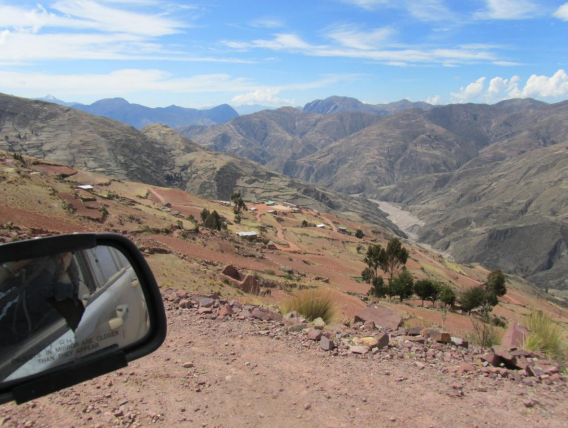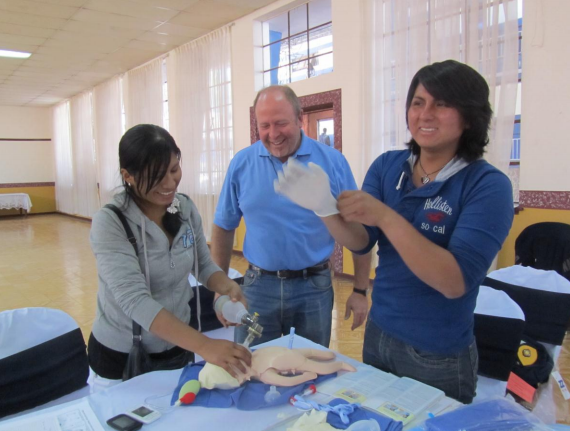Nancy L. Branning, CNM, ND, Santa Fe, NM - September 2015
Helping Babies Breathe “Stories from the Field” – Cochabamba, Bolivia, September, 2013 – Nancy L. Brannin, CNM, ND, Santa Fe, NM This was the first HBB course in Bolivia, to my knowledge. It was implemented by me, in conjunction with the Iglesia Evangélica Metodista de Bolivia (IEMB), which runs seven health clinics in rural Bolivia, often in very remote areas. I was fortunate to have the assistance during the course of Skip Hodges, a Methodist missionary in Bolivia, who is a former paramedic and was invaluable in helping with the clinical practice and testing. I was funded by the Brannin Family Foundation from Oklahoma and supported greatly by David Stephenson, the IEMB missionary to Oklahoma. The clinics are staffed by nurses who function as nurse practitioners. The nurse is often the only health care provider in the community and for hours in any direction. One of their functions is to deliver babies when necessary, and they generally have no ability to transport in the event of emergency.
The course was taught in the Instituto Evangélico Metodista, a private secondary school in Cochabamba, which generously housed all of us and provided the auditorium as our course location, along with the furniture and equipment I had requested – and the warm water for the Neonatalies! We did have a gymnasium next door, which was a little challenging noise-wise, but we were a small group (eight nurses as students, plus the dentist and school nurse had a great time auditing) and knew each other from a previous trip when I taught postpartum hemorrhage control, so we focused on the work at hand. The students were enthusiastic and quick learners. Everyone succeeded in learning how to suction and use the bag valve mask and passed the written and practical tests, at least by the second try. They loved the equipment and were delighted that each clinic received a bag with a bag valve mask, a penguin suction, surgical scissors, and surgical towels to wrap the scissors for sterilization and use as a sterile field, as well as a gestational wheel and a sand timer. They also each got a laminated copy of the individual posters of the resuscitation sequence and the preparation for birth and ventilation instructions. I left a Neonatalie set there for them to use for review at their continuing education sessions.
It was wonderful and essential to serendipitously have another instructor. One person really can’t supervise eight students as they practice the skills and drills. We also had a translator, one of the school’s teachers who generously volunteered during the morning session. It is imperative, though, that the instructors be able to teach in the language if they want to complete the course in a day. Fortunately we both spoke Spanish well enough that the translator was seldom needed and we could keep the momentum going. We also had help from the director of Methodist activities in Bolivia, who kept the logistics going for us. And everyone got a t-shirt from the church, too.
As for challenges: as mentioned, the gym next door was a bit noisy. Also, we were teaching in our second language and most of the students were learning in their second language (they mostly speak Aymara or Quechua). This made the written workbook and testing more difficult for them. I wasn’t able to get the workbooks to them in advance, which would have helped a great deal with the time pressure of covering so much material in a short time. Our students were very plucky, which is why they managed to stay focused for a long seven hour course day after some of them traveled overnight by bus to get there.
We had a small child and a baby in the course as well, which was culturally appropriate and really made it more fun. One piece of advice: hide the baby cry squeeze bulb until you need it for the simulations!
I got my large poster and all the smaller posters laminated, which was absolutely essential, as the teaching materials and equipment all went in my suitcase and the nurses would be carrying their small posters in their backpacks on motorcycles or bicycles through the Andes or Bolivian jungle.
I hope that others will upload their stories, as I found them very helpful as I prepared for this course. Thanks to all the wonderful people in Bolivia who made this course possible and to the nurses who serve their communities under such difficult conditions.








Last Updated
08/26/2021
Source
American Academy of Pediatrics